Accepted Scientific Name: Echinocereus russanthus D.Weniger
Cact. Succ. J. (Los Angeles) 41: 41(-42), fig. 5. 1969
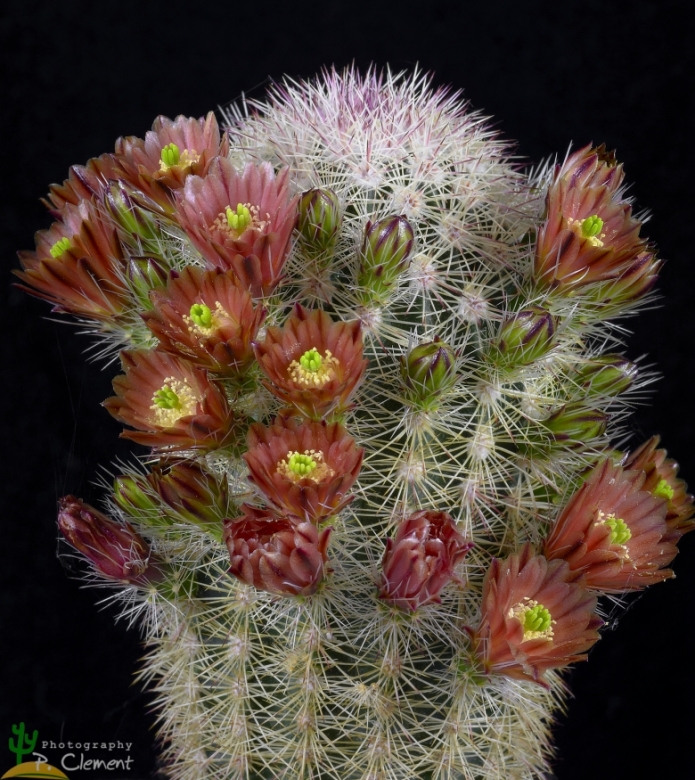
Echinocereus russanthus subs. fiehnii Photo by: Peiffer Clement
Origin and Habitat: It is endemic to the Sierra del Nido, Santa Clara Cañón, central Chihuahua, Mexico.
Altitude: 1400-1800m
Habitat: Echinocereus russanthusSN|26275]]SN|21782]] subs. fiehnii grows in ascending meadow often on granite and gneiss rocks together with Mammillaria santaclarensisSN|8962]]SN|8962]] and Echinocereus palmeriSN|21782]]SN|26275]]. Night frosts are frequent in winter, and plants are often covered by snow. The plant is very rare in nature and endangered of extinction.
Synonyms:
See all synonyms of Echinocereus russanthus
back
Accepted name in llifle Database:Echinocereus russanthus D.WenigerCact. Succ. J. (Los Angeles) 41: 41(-42), fig. 5. 1969Synonymy: 11
back
Description: Echinocereus russanthusSN|21782]]SN|21782]] subs. fiehnii is a controversial subspecies of the very variable Echinocereus russanthusSN|21782]]SN|21782]]. It distinguishes for its cylindrical body, many white-red spines and very small spiny pale red-yellow flowers which are among the smallest in the species. It blooms quite readily making this species a very interesting one at flowering time, which is usually in Spring.
Habit: Single stemmed, or later becoming branched, some having as many as a dozen.
Stem: Erect, spheric to short cylindric, 8-30 tall and 4-8 cm in diameter.
Ribs: 10-20, crests prominent, slightly to conspicuously undulate; areoles 3-12 mm apart.
Spines: Interlocking, bristle-like slender, typically white and reddish obscuring the stems, radiating in all directions.
Flowers: Diurnal, often occurring in clusters around the sides of the stem, shortly funnelform, 2-3,5 long 1,5-3 cm broad not always opening fully; typically pale yellow-red or rust-red, often with darker purplish maroon midstripes, anthers greenish-yellow.
Flowering: March - June.
**Fruits: Yellowish green, dark green, reddish tinged or dark purple, green, very spiny, 6-17 mm, pulp white.
Fruiting:*** Fruits ripen 2 months after flowering.
Subspecies, varieties, forms and cultivars of plants belonging to the Echinocereus viridiflorus/russanthus complex
 Echinocereus carmenensis W.Blum, Mich.Lange & E.Scherer in W.Blum et al.: has stocky body covered by tight yellowish pectinate spines and peculiar chocolate-scented flowers. Distribution: La Cuesta, passo Sierra del Carmem, Coahuila, Mexico.
Echinocereus carmenensis W.Blum, Mich.Lange & E.Scherer in W.Blum et al.: has stocky body covered by tight yellowish pectinate spines and peculiar chocolate-scented flowers. Distribution: La Cuesta, passo Sierra del Carmem, Coahuila, Mexico. Echinocereus milleri W.Blum, Kuenzler & Oldach: has the "hairy" seedlings of Echinocereus viridiflorus var. neocapillus, but has fewer spines it is also similar to the yellow spined Echinocereus viridiflorus subs. Correllii (which it obviously is not).
Echinocereus milleri W.Blum, Kuenzler & Oldach: has the "hairy" seedlings of Echinocereus viridiflorus var. neocapillus, but has fewer spines it is also similar to the yellow spined Echinocereus viridiflorus subs. Correllii (which it obviously is not). Echinocereus russanthus D.Weniger: has spheric to cylindrical stems, 8-30 tall and 4-8 cm Ø; ribs 10-20. Spines: Interlocking, bristly, typically reddish to brown, radiating in all directions. Distribution: Chihuahua (Mexico) and N-W Texas (USA).
Echinocereus russanthus D.Weniger: has spheric to cylindrical stems, 8-30 tall and 4-8 cm Ø; ribs 10-20. Spines: Interlocking, bristly, typically reddish to brown, radiating in all directions. Distribution: Chihuahua (Mexico) and N-W Texas (USA). Echinocereus russanthus f. cristata hort.: crested form.
Echinocereus russanthus f. cristata hort.: crested form. Echinocereus russanthus subs. fiehnii (Trocha) W.Blum & Mich.Lange: Distribution: endemic to the Sierra del Nido, central Chihuahua, Mexico.
Echinocereus russanthus subs. fiehnii (Trocha) W.Blum & Mich.Lange: Distribution: endemic to the Sierra del Nido, central Chihuahua, Mexico.- Echinocereus russanthus subs. weedinii Leuck ex W.Blum & Mich.Lange in W.Blum et al.
 Echinocereus viridiflorus Engelm. in Wisliz.: ssp. viridiflorus (Typical form) With small stems and relatively pure yellow flowers, extends from central New Mexico and the Texas Panhandle to South Dakota.
Echinocereus viridiflorus Engelm. in Wisliz.: ssp. viridiflorus (Typical form) With small stems and relatively pure yellow flowers, extends from central New Mexico and the Texas Panhandle to South Dakota. Echinocereus viridiflorus var. canus A.M.Powell & Weedin: has hairy juvenile forms. Distribution: Solitario, Sandstone ridge above Righthand Shutup, Presidio Co., Texas, USA.
Echinocereus viridiflorus var. canus A.M.Powell & Weedin: has hairy juvenile forms. Distribution: Solitario, Sandstone ridge above Righthand Shutup, Presidio Co., Texas, USA. Echinocereus viridiflorus subs. chloranthus (Engelm.) N.P.Taylor: has 10-18 ribs, 5 or more central spines, giving the plants a bristly appearance, it is often considered a separate species (Echinocereus chloranthus). Distribution: W. Texas, S.E. New Mexico, and N. Mexico.
Echinocereus viridiflorus subs. chloranthus (Engelm.) N.P.Taylor: has 10-18 ribs, 5 or more central spines, giving the plants a bristly appearance, it is often considered a separate species (Echinocereus chloranthus). Distribution: W. Texas, S.E. New Mexico, and N. Mexico. Echinocereus viridiflorus subs. correllii (L.D.Benson) W.Blum & Mich.Lange in W.Blum et al.: It is a poorly defined, yellow-spined population near Marathon, Texas.
Echinocereus viridiflorus subs. correllii (L.D.Benson) W.Blum & Mich.Lange in W.Blum et al.: It is a poorly defined, yellow-spined population near Marathon, Texas. Echinocereus viridiflorus cowperii n.n.: same as: Echinocereus viridiflorus var. rhyolithensis.
Echinocereus viridiflorus cowperii n.n.: same as: Echinocereus viridiflorus var. rhyolithensis. Echinocereus viridiflorus subs. cylindricus (Engelm.) N.P.Taylor: The common morphotype grows at middle altitudes in Texas and southeastern New Mexico, it has 0-2(-3) central spines.
Echinocereus viridiflorus subs. cylindricus (Engelm.) N.P.Taylor: The common morphotype grows at middle altitudes in Texas and southeastern New Mexico, it has 0-2(-3) central spines. Echinocereus viridiflorus subs. davisii (Houghton) N.P.Taylor: In the broad sense Echinocereus viridiflorus may prove paraphyletic with respect to Echinocereus davisii, but they are phenologically isolated, with Echinocereus davisii flowering earlier and thus appearing reproductively isolated in the wild.
Echinocereus viridiflorus subs. davisii (Houghton) N.P.Taylor: In the broad sense Echinocereus viridiflorus may prove paraphyletic with respect to Echinocereus davisii, but they are phenologically isolated, with Echinocereus davisii flowering earlier and thus appearing reproductively isolated in the wild. Echinocereus viridiflorus subs. davisii cv. brevispinus hort.: has very short spines, usually radial, pectinated, stout, fang like, white whit a dark contrasting tip 2-4 mm long. Spine clusters looks like small starfishes.
Echinocereus viridiflorus subs. davisii cv. brevispinus hort.: has very short spines, usually radial, pectinated, stout, fang like, white whit a dark contrasting tip 2-4 mm long. Spine clusters looks like small starfishes. Echinocereus viridiflorus var. montanus hort.: has significantly depressed stems solitary or in low clusters (mostly less than 2 cm tall). Distribution: Southwestern USA (Monarch Pass, Colorado?)
Echinocereus viridiflorus var. montanus hort.: has significantly depressed stems solitary or in low clusters (mostly less than 2 cm tall). Distribution: Southwestern USA (Monarch Pass, Colorado?) Echinocereus viridiflorus var. neocapillus (D.Weniger) A.D.Zimmerman: Remarkable for its softly hairy, not sharply spiny, seedlings.
Echinocereus viridiflorus var. neocapillus (D.Weniger) A.D.Zimmerman: Remarkable for its softly hairy, not sharply spiny, seedlings.- Echinocereus viridiflorus var. rhyolithensis W. Blume & Mich.Lange: (Echinocereus russantus forma) Bristly red-spined plants from New Mexico.
 Echinocereus viridiflorus var. robustior Kuenzler: It is a more robust form but not sufficiently differentiated and considered merely a local variant of Echinocereus viridiflorus var viridiflorus. Distribution New Mexico.
Echinocereus viridiflorus var. robustior Kuenzler: It is a more robust form but not sufficiently differentiated and considered merely a local variant of Echinocereus viridiflorus var viridiflorus. Distribution New Mexico.
Bibliography: Major references and further lectures
1) David Hunt, Nigel Taylor “The New Cactus Lexicon” DH Books, 2006
2) John Pilbeam (1999) “Mammillaria The Cactus File Handbook” Nuffield Press.
3) Edward F. Anderson “The Cactus Family” Timber Press, 2001
4) James Cullen, Sabina G. Knees, H. Suzanne Cubey “The European Garden Flora Flowering Plants: A Manual for the Identification of Plants Cultivated in Europe, Both Out-of-Doors and Under Glass”Cambridge University Press, 11/ago/2011
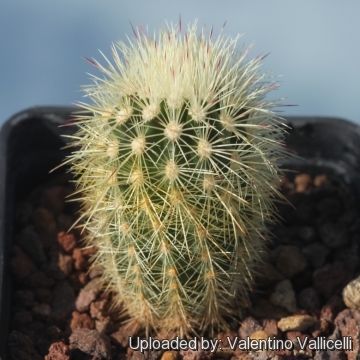 L1076 (Alfred Bernhard Lau) Santa Clara Canyon, Chihuahua, Mexico, 1400-1800 m a.s.l. Photo by: Valentino Vallicelli
L1076 (Alfred Bernhard Lau) Santa Clara Canyon, Chihuahua, Mexico, 1400-1800 m a.s.l. Photo by: Valentino Vallicelli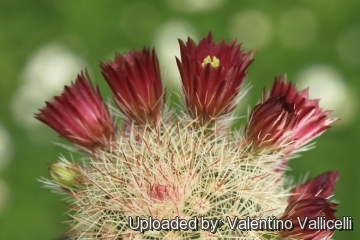 Echinocereus russanthus subs. fiehnii Photo by: Valentino Vallicelli
Echinocereus russanthus subs. fiehnii Photo by: Valentino Vallicelli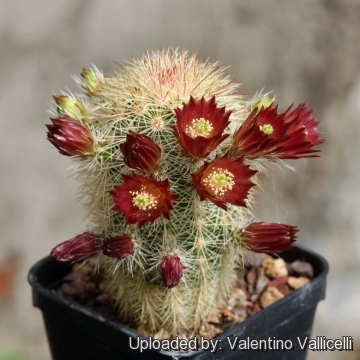 Echinocereus russanthus subs. fiehnii Photo by: Valentino Vallicelli
Echinocereus russanthus subs. fiehnii Photo by: Valentino Vallicelli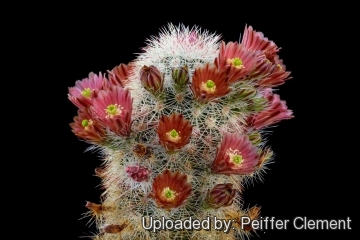 Echinocereus russanthus subs. fiehnii Photo by: Peiffer Clement
Echinocereus russanthus subs. fiehnii Photo by: Peiffer ClementCultivation and Propagation: In culture Echinocereus russanthusSN|21782]]SN|21782]] is without problems and regularly shows its small purplish flowers if we provide an adequate winter rest period. It is sensitive to overwatering (rot prone) needs good drainage, Keep drier and cool in winter. Need full sun; Very cold resistant hardy to -20° C or less for short periods of time.
Propagation: Seeds or cutting (if available).














